Night Vale Book Tour Slays Hundreds

It was a dark and stormy night.
Dreary gray clouds dragged themselves across a dreary gray sky. It was cold. It was raining.
Inside there was a shuffle of feet. The scrape of a door. A slight sense of…apprehension? And a sound. A peculiar sound. A murmur of hundreds of voices. A whisper of a thousand turning pages. A low hum. What was that peculiar, whispering, humming sound?
Oh. It was the sound of 500 podcast-obsessed book nerds vibrating in their seats waiting for the Welcome to Night Vale book tour to start.
On October 24th, the city of Ann Arbor opened wide its many sets of alien arms to welcome Joseph Fink and Jeffrey Cranor, creators of the popularly creepy and creepily popular Welcome to Night Vale podcast to town. The show is about a fictitious desert town where werewolves, ghosts, and mysterious lights in the night sky are familiar and routine, the weather is music, and the sleepy town’s supernatural goings-on are all calmly broadcast over the radio for everyone to hear.
Hosted by Literati Bookstore, Fink and Cranor came to Ann Arbor for an hour of questions, answers, and a brief reading as part of a nation-wide tour for their newly released novel Welcome to Night Vale.
Included in the price of the ticket were the following essential items:
-One seat (mostly for sitting, but possible for use as a shield against wild beasts, unknown hooded figures, or existential crises)
-One copy of the new book to take home and read to yourself, to your family, or loudly to strangers at the bus stop
-Human contact (optional)
In the auditorium of Emerson School, the authors took their seats on stage and faced the terrifying horde: hundreds of Night Vale fans wearing their most intricate costumes, their most supportive Night Vale T-shirts, screaming their sincerest screams of excitement.
For a fandom that prizes the mysterious, eerie, and monstrous so highly, it was probably the friendliest event I’ve ever been to.
Singer, rapper, and host Dessa Darling provided most of the questions and all of the enthusiasm allowed by law. She opened the event with a simple question for creator Joseph Fink: “If I were to corner your grandmother in an elevator, what would she have to say about Night Vale’s success?”
From there, it was pretty much a delightfully wacky journey from hilarious anecdotes about Welcome to Night Vale's narrator doing podcasts in his underwear to some Super Heavy Serious Metaphysical Stuff.
This was what impressed me most about the event. The questions, the authors' answers, and the brief reading of the book itself all proved the depth of feeling and philosophical thought that the Night Vale universe both creates for and evokes in its listeners.
I don’t know if you knew this, guys, but despite being pretty funny, Welcome to Night Vale is some deep shit.
Sure, the Q & A included questions as simple as “Do you think this book is going to be banned?” (to which Fink replied, “I hope so!”). But there were also questions as complex as asking the authors what it means to have a body, a physical form as a catalyst for all of your interactions with the world, and if our bodies ultimately determine our destinies.
Yeah. See? Deep.
As an occasional Night Vale podcast listener at an event that seemed to consist entirely of fans who had already heard all 80-or-so episodes and devoured half the book in the fifteen minutes between the hardback hitting their palms and the two creators appearing onstage, I realized one thing pretty quickly: the Night Vale fandom is one that makes you want to be pulled down into its gaping maw. The fans at this event cheered at everything. They clapped at everything. They laughed at everything. They told the guy who took to the microphone before the event had even started—the dude who was only up there to tell them the boring rules of safety and not to trample each other on the way out—that they loved him.
They screamed this. Repeatedly. And they meant it.
Between the positively-charged atmosphere of the event, the clearly devoted and downright pleasant fans, and the creators who have put way more thought into their writing than you might imagine, it was enough to make you wonder: Can I please take a bus to this Night Vale place, or do I need to be dropped from a mother ship into their town square?
Based on the brief 3-page reading done by Jeffrey Cranor and the 20 pages I got through while waiting for the show to start, readers of Welcome to Night Vale can expect the usual dark humor, a cast of strange and mysterious characters, an equally mysterious double-mystery, shape-shifters, sentient houses, and a lot of made-up quotes from famous people.
But, as Eleanor Roosevelt once said, “This is the end of the article.”
Nicole Williams is a Production Librarian at the Ann Arbor District Library. She prefers her meat rare and has never been seen at work on a full moon.
Music Preview: The Ragbirds Halloween Masquerade with Rhyta Musik

Still working on your Halloweekend plans? Tonight, the Ark welcomes The Ragbirds back to their hometown stage. The hard-working and hard-touring band is built around Erin Zindle, a musician who is as comfortable singing-while-playing violin as she is wielding an accordion.
This last year, Zindle and crew have been hard at work on their fifth studio record with Grammy-nominated producer Jamie Candiloro (Ryan Adams & The Cardinals, Willie Nelson), and this show gives fans a chance to hear much of that material prior to its 2016 release.
The Ragbirds often go all-out to celebrate this spooky holiday, and accordingly, this year’s performance goes beyond just a “show” — it’s a full-on masquerade, for the band and fans.
Rhyta Musik kicks off the revelry with their very own bombastic, vibrant take on traditional Eastern European folk melodies, already a hit around Ann Arbor at this last year's Water Hill Music Fest.
Come already decked out, or arrive early — there will be a special souvenir masquerade mask for the first 250 people.
Mariah Cherem is a Production Librarian at the Ann Arbor District Library.
The Ragbirds' Halloween Masquerade with Rhyta Musik will be held tonight, Friday, October 30, at the Ark. Doors open at 7:30 pm, show starts at 8 pm. Tickets are $20 and can be purchased online in advance until 3pm or at the Ark Box office.
Movie Review: That Strange Summer

In the summer of 1975, a number of patients at the Veterans Administration Hospital in Ann Arbor suffered sudden respiratory failure. Several patients died as a result. The FBI investigated and two Filipina nurses, Leonora Perez and Filipina Narcisco, were eventually convicted of injecting patients with a drug intended to incapacitate and kill them. This little-known story is the focus of That Strange Summer, a documentary by journalist and associate professor Geri Alumit Zeldes.
In interviews in the film, co-workers express doubt about the pair’s guilt, and question why another co-worker, who was obviously unstable, was not considered as more of a suspect. A victim’s family recounts the shock of these attacks, and the struggle to understand what had happened. An investigator shares the circumstantial evidence used to justify official suspicions. Throughout, the nurses stand by one another despite their shock at the accusations and the gravity of the situation. Their conviction met with protests, and on appeal, their conviction was overturned and the nurses were freed.
Filmmaker Zeldes unfolds this complicated story through archival news stories, FBI documents, and eye-opening interviews with investigators and former VA employees. The film examines stereotypes and perceptions that may have influenced the outcome of the investigation and trial. People in the film keep coming back in amazement that such a thing took place in Ann Arbor -- underlining that distrust of foreigners can exist anywhere, and the story of Narcisco and Perez shows just how far that distrust can go.
Sara Wedell is a Production Librarian at the Ann Arbor District Library.
That Strange Summer is available to stream on aadl.org. You can also see the investigation and trial unfold through Ann Arbor News articles from the era from AADL’s Old News archive.
Canoe Imagine ART?!
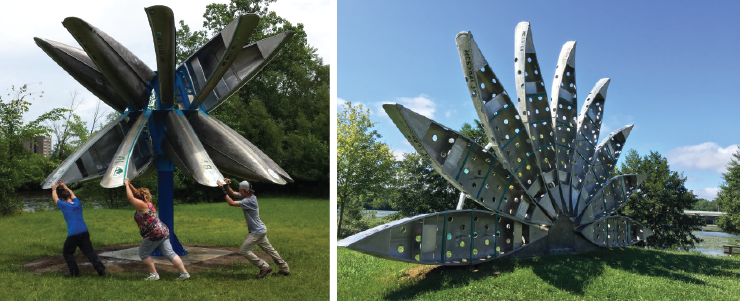
Fall is fully upon us with the falling leaves, colder temps, and strong winds, but it's still a fantastic time of year to be outside and soak up everything that Ann Arbor's parks have to offer! There are now sculptures located in four of Ann Arbor's parks: Broadway Park, Gallup Park, Island Park, and Bandemeer Park. Canoe Imagine Art (CIA), which debuted in August, is a unique partnership created by The Arts Alliance, in cooperation with the City of Ann Arbor (the City) and the Ann Arbor Public Art Commission (AAPAC). CIA repurposes retired canoes and celebrates everything about the Huron River and the City's extraordinary park system. Four works of art were selected through a juried and public vote process.
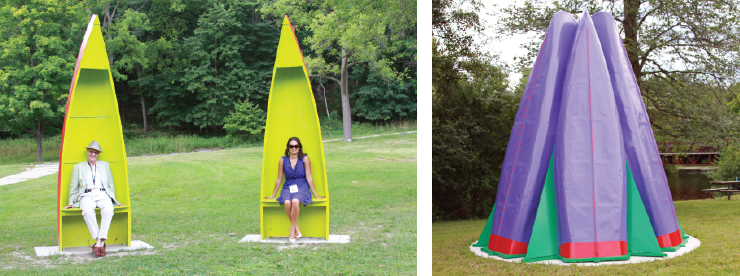
The "Turbine" sculpture in Broadway Park is a kinetic piece that uses the canoes to create a visual wheel that spins and was inspired by the movement and occasional turbulence of the river. Gallup Park has a "Canoe Fan" that evokes the feeling of a rising sun. This piece really showcases the shape of the canoe and heightens it to a different beautiful form. Island Park is home to "Canoe-vue", turning two canoes cut in half into a functional place to sit - sitting in art to observe the art of nature. Lastly, Bandemeer Park is home to "Tulip" - 10 canoes standing vertically and meeting at one point in the middle. This piece celebrates the shape of the canoe while emulating a shape found in nature.
Before the rains turn to ice and the snow we're all hoping doesn't come (fingers crossed, El Nino!) covers the canoes get out there and explore the natural and sustainable art!
Erin Helmrich is a Production Librarian at the Ann Arbor District Library - when it comes to water she prefers kayaks.
No Guts, No Story: The Moth's Monthly Ann Arbor StorySLAM

Every month crowds gather at Circus for The Moth StorySLAM, Ann Arbor's live, local version of the hugely popular NPR radio show The Moth Radio Hour. Just like the show, Ann Arbor's StorySLAM features true, personal stories told by people of all ages, backgrounds, and storytelling skill-levels--as long as they've got the guts to get up on stage and tell.
At this past Tuesday’s Ann Arbor StorySLAM, storytellers had to bring twice the guts--because “Guts” was also this month's theme. Satori Shakoor, creator, producer, and host of The Secret Society of Twisted Storytellers, was StorySLAM's enthusiastic host, welcoming storytellers to the stage and reading brief “times I chickened out” anecdotes submitted by the audience in between stories. Storytellers displayed a wide range of abilities as they shared a diversity of "gutsy" stories. Opener Karin Lindstrom told a dramatic tale of having to kill a beloved horse, while eventual winner Lauren Trimble shared a tearful story of having to identify the body of her dead brother. Other storytellers interpreted “guts” more literally; KT Doud told a story of offending international hosts by refusing to eat intestine soup… and then accidentally furthering the offense with too many tequila shots.
Circus makes a great venue for the event, with its raised stage and combination of tables, chairs, and standing room. It’s fun to see the different abilities of the storytellers and their individual interpretations of each monthly theme. For those who don't faint dead away at the thought of public speaking, it's actually pretty easy to join in on one of these StorySLAMs. Those who wish to tell a story submit their name and 10 random storytellers are chosen to share their 5-minute story with the crowd and with a panel of judges. The StorySLAM winner continues on to compete in a larger GrandSLAM, a storytelling event with winners from StorySLAMs around the country.
Elizabeth Pearce is a Library Technician at the Ann Arbor District Library.
Ann Arbor's StorySLAM is sponsored by Michigan Radio and is held on the third Tuesday of every month at Circus. The event will be back on November 17, with the theme “Gifted,” and on December 15, with the theme “Joy.” Tickets are $9 each for nonparticipants, and you can buy them online in advance or at the door. For more information and Detroit dates, visit the Moth events website.
Art Blooms in Hamtramck
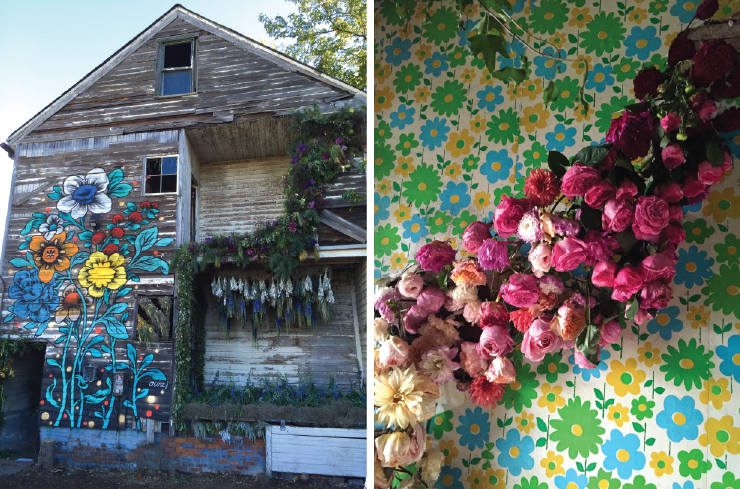
Crowds flocked to a vacant house on Dequindre St. in Hamtramck this weekend, all seeking an experience more likely to be found in a botanical garden or conservatory. The house, named simply Flower House, was created by Lisa Waud of Ann Arbor and Detroit-based Pot & Box, and features an amazing large-scale floral installation created using American-grown fresh flowers and living plants.
Waud and a team of floral designers from Michigan and throughout the country came together to create stunning floral installations throughout every room of a vacant and dilapidated house, sometimes extending from ceiling to floor or wall to wall.
During the three-day sold-out event, over 2,000 attendees each had 20 minutes to make their way through all 17 rooms in the house and revel in the experience. Walking through the dreamscape and floating from room to room was completely enchanting, and absorbing your surroundings was a delightful challenge. Your eyes roamed around in sensory overload trying to take in each room as a whole while also trying to notice all of the beautiful details tucked into every nook and cranny.
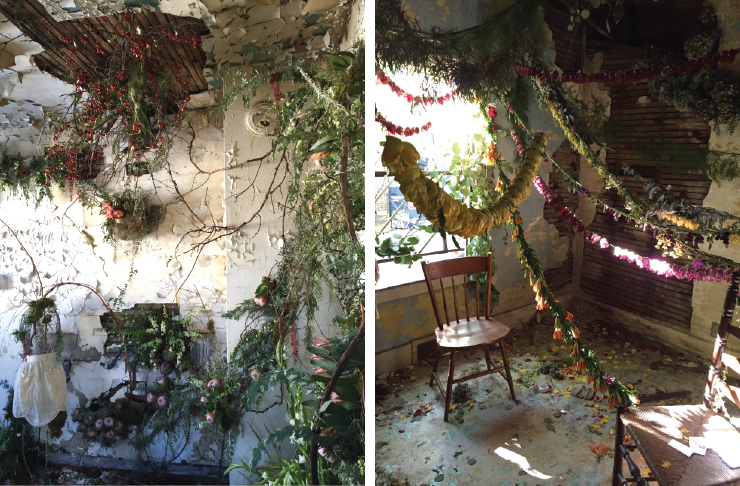
The bedroom housed a bed made of moss and branches, the bathrooms featured the prettiest, sweetest-smelling toilets you’ve ever seen, and the colorful old kitchen cupboards were adorned with greens amid the plates and silverware. Tulips dripped from the ceiling alongside peeling paint, interwoven marigolds created a playful shower curtain, and vegetables cascaded gracefully over crumbling walls. To complete the scene, the house was enveloped in the crisp smell of thousands of flowers on a chilly fall day while the admiring gasps of awestruck onlookers created a chorus to accompany the dreamy beauty of Flower House.
With the installation now ended, the house and its neighboring vacant house will be deconstructed and the materials will be repurposed. The land will then be turned into a flower farm and design space, in a continuation of Flower House's success in growing fresh beauty from a tired landscape.
Amanda Schott is a Library Technician at the Ann Arbor District Library.
Orange is the New Maize & Blue
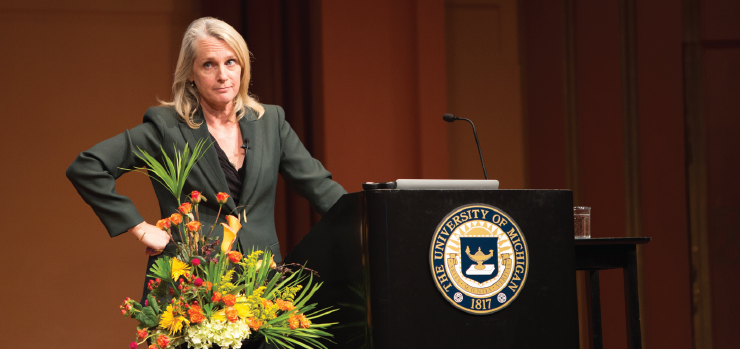
When Piper Kerman, New York Times bestselling author of Orange is the New Black, gave the biennial Vivian R. Shaw Lecture last week at the University of Michigan, she drew a crowd which filled Rackham Auditorium and required live-stream video and overflow seating. Kerman’s memoir of her experience serving time in a women’s prison was adapted into a wildly popular, award-winning Netflix series by executive producer Jenji Kohan in 2013.
Kerman’s presence throughout the lecture was relaxed, yet pointed and, at times, refreshingly irreverent. She opened the lecture by describing life prior to her 13-month incarceration at the Federal Correctional Institute in Danbury, CT. As she chronicled her time behind bars, the themes of her lecture were clear: sisterhood and empathy, gender, power, and racial inequality. Her presentation raised awareness about some damaging stereotypes and stigmas of incarcerated women, as well as challenges that occur upon re-entry to society. Kerman encouraged the audience to use the show as a lens into the greater institutional and systematic oppressions of mass incarceration and how they impact women prisoners – specifically women of color. The Q&A session that followed touched on a variety of topics including popular culture and identity, the importance of arts within prisons, and how to donate books to incarcerated women.
While Kerman currently serves as a consultant for the show, she’s also adamant about supporting nonprofits and other organizations working to advocate for female prisoners, their families, and overall prison reform. Additionally, she teaches creative writing courses to female inmates and serves on the board of the Women’s Prison Association. She has been called as a witness by the U.S. Senate Judiciary Subcommittee on the Constitution, Civil Rights, and Human Rights to testify on solitary confinement and women prisoners. She has spoken at the White House on re-entry and employment to help honor Champions of Change in the field. In 2014, Kerman was awarded the Justice Trailblazer Award from John Jay College’s Center on Media, Crime & Justice and the Constitutional Commentary Award from The Constitution Project.
In this talk, Kerman offered incredible insight and compassion as she both humanized female prisoners and advocated for thoughtful, intentional, and long-term policy changes.
The 2015 Vivian R. Shaw lecture was co-sponsored by the Institute for Research on Women and Gender, Women Studies Department, Michigan Law School, the Gerald R. Ford School of Public Policy, the School of Social Work, the Department of Screen Arts and Cultures, the Department of Sociology, and the Screen Arts and Cultures Screenwriting Program.
Community contributor CristiEllen Heos Zarvas is the Meetings and Special Events Assistant for the Institute for Research on Women and Gender at the University of Michigan.
Review: POP•X
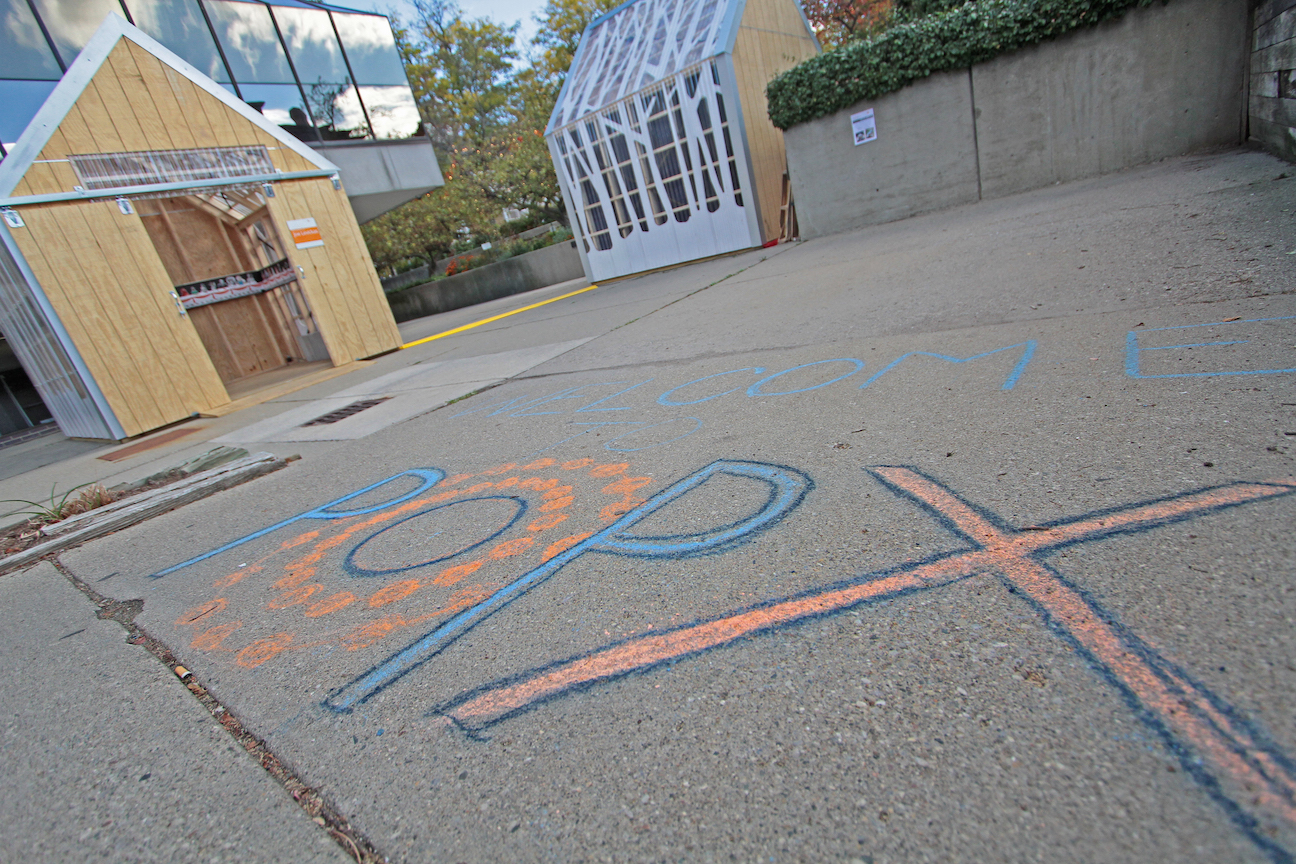
At the entrance to a 10’ x 10’ pavilion made of plywood and corrugated plastic at the edge of Liberty Plaza, I feel like I’m peering into some sort of mystical forest. Past the artificial palm fronds that frame the doorway, there are tall, mossy, finger-like artificial rocks awash in gentle blue light. Cottony clouds hang from the ceiling and recorded sounds of wind and woodland activity play softly.
A sweatshirt-clad, middle-aged man with a scraggly beard steps up behind me and I turn around. His expression is puzzled.
“Is there weed in there or something?” he asks.
“No,” I reply. “It’s an art installation.”
The pavilion containing Ann Arbor artist Nick Zagar’s forest landscape is one of eight pop-up structures comprising the Ann Arbor Art Center’s new POP•X exhibition in Liberty Plaza. Even at a cordoned-off POP•X preview event, it’s impossible not to confront the odd dichotomy between the plaza’s typical usage and the purpose it will take on for the next 10 days. Ann Arborites know the downtown park as a regular hangout for the homeless, the subject of repeated city council debate. Through October 24, however, it will be the site for POP•X, which organizers describe as the first step in a larger mission to create more publicly accessible art experiences in the Ann Arbor community.
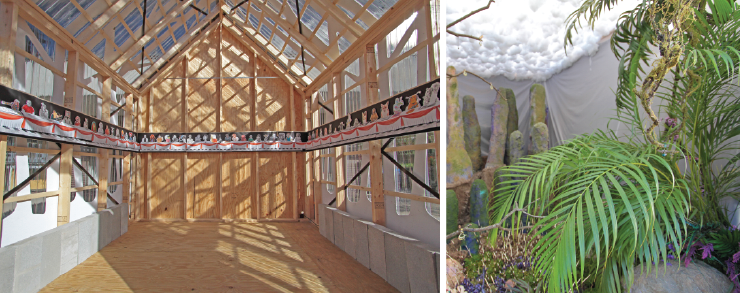
All eight pavilions look essentially the same from the outside: unfinished wooden doorways at the front and back, with white silhouettes of trees crisscrossing the transparent sides and roofs. Inside, each pavilion is unique, tailored to the eccentricities of the artist or group who worked on it. Where Zagar fills his entire pavilion with his fantasy naturescape, artist Joe Levickas’ pavilion contains just a narrow band of illustrations of cartoon figures sitting down to a dinner party, like a surrealistic 50-person “Last Supper” stretching across three walls.
However, the most interesting pavilions at POP•X are those that directly engage with Liberty Plaza’s usual population and associated issues of economic disparity. Brenda Oelbaum’s somber installation uses black curtains to block out the light that streams into most POP•X pavilions, with a large mural inside presenting a quote Oelbaum’s grandmother adapted from Herodotus: “If we all put our troubles in bags and took them to the market to exchange them, upon seeing the problems of others we would gladly go home with our own.” Visitors are encouraged to write down their problems and leave them anonymously in a pile of small black pouches. Visitors may then read others’ problems and “purchase” them for a donation to the Ann Arbor Community Center or Mercy House, both charities supporting Ann Arbor’s hungry and homeless.
Just across from Oelbaum’s installation is a pavilion designed by the nonprofit Girls Group, which focuses on empowering young Ann Arbor and Ypsilanti women to stay in high school or college and avoid teen drug use and pregnancy. The group’s young participants have contributed a variety of works based on the concept of “home.” The most powerful work in the pavilion is a looping video of Dea Chappell, a fiery young Ann Arbor poet and high school junior, reading her poetry. “Welcome to black America,” Chappell almost sobs. “I can’t breathe…but black lives matter, right?” Standing by her untitled collage addressing themes of black sisterhood and protest, 17-year-old Skyline High School student Alexandra Cash tells me living in Ann Arbor has made her more aware of her “blackness.” “You can be really smart and get really good grades but still be on the lower end of the white kids,” Cash says.
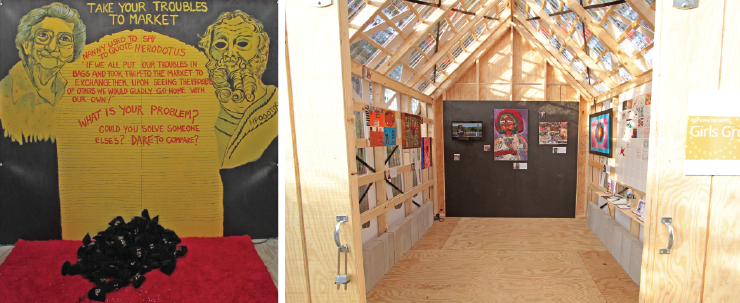
Ypsilanti artist Nick Azzaro’s pavilion provides POP•X’s most direct statement on Liberty Plaza’s usual inhabitants, and one of the most powerful statements in the show overall. At the center of Azzaro’s installation is “The Statue of Liberty Plaza,” a figure built from hundreds of tiny plastic army men and other military-related toys, posed in the form of Lady Liberty. The figure wears torn jeans, stuffed with newspaper and corrugated cardboard. In one hand it holds a copy of Groundcover News, in the other a sign reading “HOW ARE YOU TODAY?” On the walls surrounding the statue are professional portraits of individuals Azzaro met while spending an average, non-POP•X day in Liberty Plaza. The portraits are larger than life and most of the subjects grin broadly as they look directly into the camera, a white background behind them. Azzaro’s work encourages visitors to gaze upon the “huddled masses” we might otherwise ignore as we walk past Liberty Plaza, and to find a welcoming expression and a human story there.
Adjacent Azzaro’s pavilion is a more traditional representation of Ann Arbor’s art establishment. The Ann Arbor Women Artists’ pavilion, a collaboration between 30 of the 64-year-old organization’s members, is a delightful Art Nouveau-inspired outdoor picnic scene. Ruffled tissue-paper grass surrounds a painted pathway through the pavilion, suggesting a river. Plates are heaped with clay and Styrofoam fruits and vegetables, and dragonflies made of wire and tissue paper float overhead. It’s lavish, lovely and certainly more focused on craftsmanship and aesthetic beauty than political commentary.
But that’s part of why POP•X works so well. I was initially unsettled by the idea of an art show displacing Ann Arbor’s less fortunate for 10 days. But while POP•X’s organizers set out to bring art to the whole community, they’ve achieved something even higher: bringing our community face to face with itself. POP•X doesn’t whitewash Liberty Plaza for the enjoyment of some artistic elite, nor does it shut out more traditional voices from our local art scene. It forces anyone who explores all eight pavilions to confront diverse aspects of a complex town that is too often described in generalizations. Here, a Liberty Plaza regular may wander through the Women Artists’ picnic wonderland, or one of the well-dressed socialites I rubbed shoulders with at the preview event may take a moment to look into the eyes or listen to the words of Ann Arborites considerably less fortunate than him or herself. POP•X is many things: fun, sobering, beautiful, contemplative. But most importantly it’s responsible and respectful to the full scope of the community it represents.
Patrick Dunn is an Ann Arbor-based freelance writer whose work appears regularly in the Detroit News, the Ann Arbor Observer, and other local publications. He can be heard most Friday mornings at 8:40am on the Martin Bandyke morning program on Ann Arbor's 107one.
POP•X runs Thursday, October 15 – Saturday, October 14, 2015 from 10am to 8pm at Liberty Plaza Park, 255 East Liberty St., Ann Arbor. To learn more visit popxannarbor.com or the POP•X Facebook event page. POP•X is free and open to the public.
Romeo is Bleeding, and You Are Sobbing

There are very few films that can leave a person full-on ugly-crying in their seat and contemplating gun violence, poverty, creativity, and Shakespeare simultaneously, but Jason Zeldes’ 2015 documentary Romeo is Bleeding manages it.
The film follows Donté Clark, a young poet and emcee from Richmond, California as he struggles to rise above the violence of his hometown and the endless turf war between North and Central Richmond, two cities with bad blood to spare.
The film can claim a whole host of achievements, but above all, it succeeds in truly masterful storytelling. The story of Donté Clark’s journey from aimless youth to poet and activist and the story of the decades-old turf war inherited by the inhabitants of Central Richmond and North Richmond are seamlessly interwoven. The entire film is given perspective and focus by following the timeline of a third story: the efforts of a group of Richmond’s teen poets, including Donté, as they create and perform a production of Romeo and Juliet—with a twist, of course, because if there’s one thing this film doesn’t offer, it’s predictability. The well-known rivalry of the Montagues and Capulets is replaced with the completely different, but eerily parallel, rivalry of North and Central Richmond.
That’s right. Plot twist.
It’s amazing how well these two ideas come together, as the timeless verse of Shakespeare translates so perfectly to the gritty, almost slam-style poetry that the kids of Richmond perform when they take the stage.
And while the film may take place hundreds of miles from Ann Arbor, there’s a lot of local interest, not only through the film’s homegrown director Zeldes, but through one of the documentary’s main characters: Donté’s teacher and mentor, Molly Raynor, an Ann Arbor local who learned her love of writing and passion for poetry at Ann Arbor’s very own Neutral Zone.
The film is currently on the film festival circuit and recently won its 10th award.
Nicole Williams is a Production Librarian at the Ann Arbor District Library and her cry-face is hideous.
First Fridays Ypsilanti: Bee-decked in Art
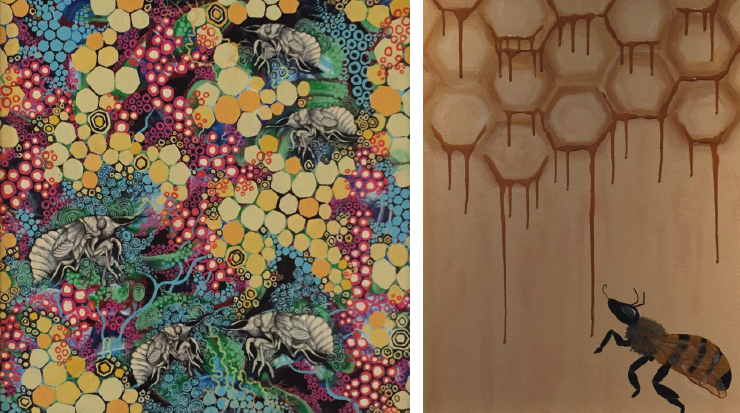
First Fridays Ypsilanti, the monthly art-walk that invites locals on self-guided art tours through the city, generated buzz this September using bees as a theme for artist inspiration. In honor of Ypsi’s third annual Festival of the Honey Bee, local cafés, restaurants, and galleries became temporary homes to some bee-autiful art pieces, ranging from the truly enormous to the wonderfully weird.
It seems as if no work was too big or too small, and no medium too strange for this art crawl, and the result was a veritable explosion of artwork branching out in unexpected directions from the unified bee theme.
Some artwork hung traditionally in frames, like the pieces on the walls at Beezy’s and Café Ollie, which ranged from collages of paper bees exploring paper leaves to photographs of real bees swarming in their hive.
Some artwork hung from the ceiling by string, like the bizarre (bee-zarre?) mixed-media piece “Lady Bug Lady,” a doll covered in glitter and spots, connected to the theme by a set of sparkly antennae peeking through the doll’s purple hair at the 22 North Art Gallery.
At the Bona Sera Café, a massive, lifelike black-and-gold papier-mâché bee looked like it had just flown in and settled on the brick walls.
And, of course, the art crawl wouldn’t have been complete without some truly solid bee puns, like the whimsical piece titled “Let’s Bee Friends.”
The bee-related installment came down at the end of September. Plan your visit for the next First Friday on November 6th.
Nicole Williams is a Production Librarian at the Ann Arbor District Library and is terrified of bees.


































